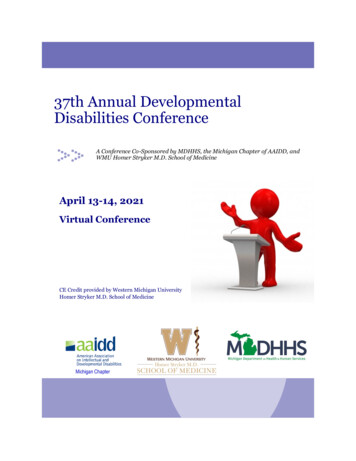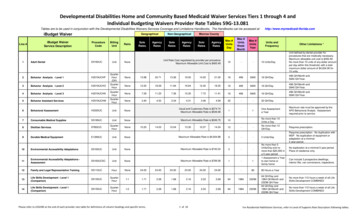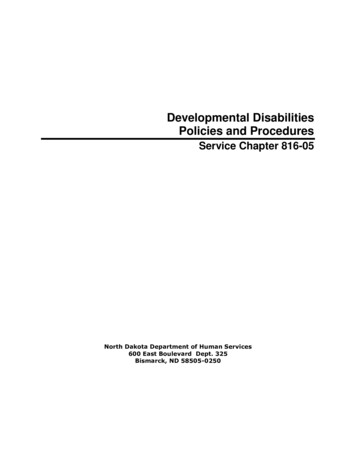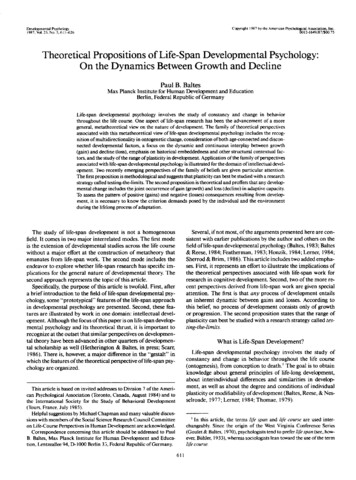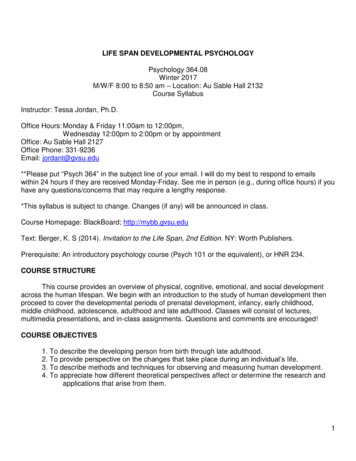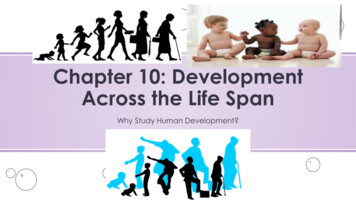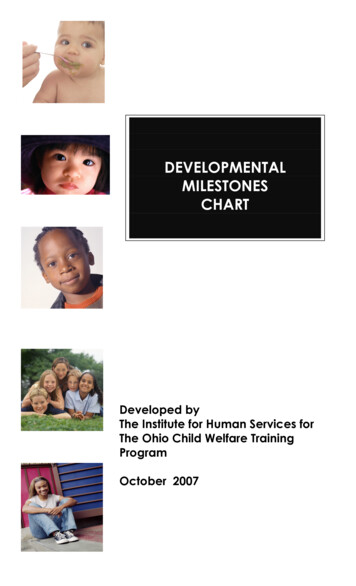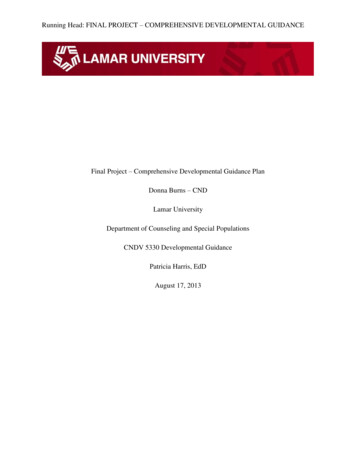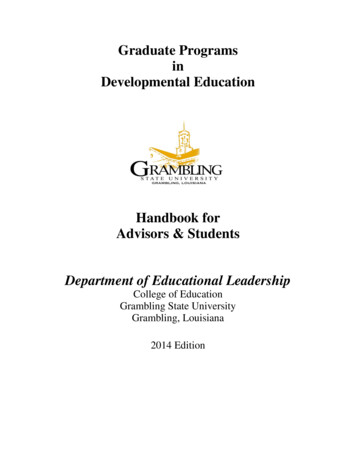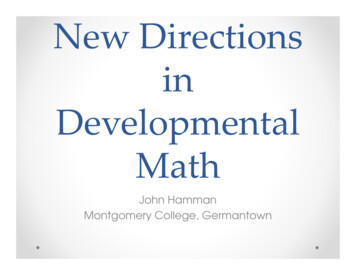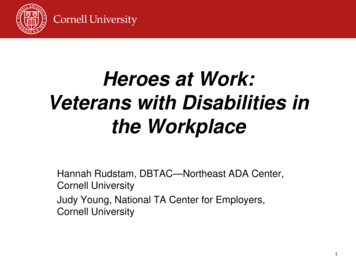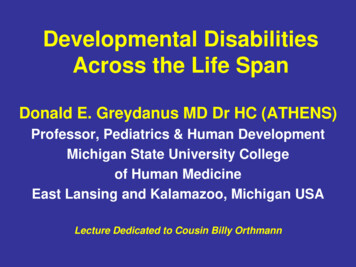
Transcription
Developmental DisabilitiesAcross the Life SpanDonald E. Greydanus MD Dr HC (ATHENS)Professor, Pediatrics & Human DevelopmentMichigan State University Collegeof Human MedicineEast Lansing and Kalamazoo, Michigan USALecture Dedicated to Cousin Billy Orthmann
INTRODUCTION1. Developmental disabilities orneurodevelopmental disabilities (includesintellectual disability)2. Diverse group of chronic disorders(17% of those under 18 yrs in USA)3. Begin at anytime during the developmentprocess (including conception, birth, andgrowth) to 22 years4. Last throughout an individual‟s lifetime
INTRODUCTION1. Underlying basis for these disorders lies infundamental deficits in the developing brain2. Due to genetic, prenatal, perinatal,metabolic, and other factors3. Affect 17% of individuals younger than 18years of age in the United States4. Prevention along with early recognition andintervention are critically important5. Seek to mitigate the enormous personal andsocioeconomic impact of these disorders
LIFETIME COST FOR THOSEIN US BORN IN 2000 WITH ID1.2.3.4.Total cost: 50 billion 11 billion for cerebral palsy 2 billion for hearing loss 2.5 billion for vision impairment(Patel, Greydanus et al: Dev Disabilities Across theLifespan. Dis-a-Mon 2010; 56[6]: 304-397)
HISTORICAL PERSPECTIVE1.2.3.4.5.6.Evolved based on a firm foundation of basic andclinical neurosciencesFather of developmental pediatrics, Dr. Arnold JCapute (1923-2003)His fellows from the Kennedy Krieger Institute atJohn Hopkins UniversityNeurodevelopmental disabilities was recognizedas a specialty by the American Board of MedicalSubspecialties in 1999Involves: Neurology with Clinical & BasicNeurosciencesFocuses on care of those with developmentaldisabilities across the lifespan
Developmental Disabilities Term emerged in US in 1960s Described functional impairment,not specific etiology Legal term as per public law 95602 (1978) Does not include Mild MR Disability due to severe physicalor mental impairment
Developmental Disabilities Identified under age 22 years Likely to be chronic indefinitely(lifelong) Considerable limits in 3 or more ofareas of functioning Requires lifelong/extended carewith multidisciplinary services
DEFINITIONS Framework of World Health Organization WHO Classification of Functioning, Disability, & Health 3 components to delineate disabilities--Body Function & Structure--Activity--Participation 3 interact w/ disorder milieu personal factors(WHO, International Classification, Geneva, 2001)
DEFINITION: Disability Global Term used to encompass problemswith:---Body Functions---Body structures---Activity limitations---Participation restrictions(WHO, International Classification, Geneva, 2001)
Child with Disability(http://idea.ed.gov) US 2004 Individuals w/ Disability EducationImprovement Act (IDEA) that includes: Intellectual disability (ID); Specific learning Disabilities Hearing or visual impairments (incl deaf or blind) Speech or language impairmentsSerious emotional disturbanceOrthopedic impairmentsAutismTraumatic brain injury Other Health Impairments
Americans w/ Disability Act(http://www.ada.gov) One w/ physical or mental impairment Limits one or more major life activities Incl caring for oneself, performing manual acts Seeing, hearing, eating, sleeping, walkingStanding, lifting, bending, speaking, breathingLearning, reading, concentrating, thinkingCommunicatingWorking (6 months or more; not transient)
Intellectual Disability Developmental Delay (Correct sequence)--Sign. Delay of milestones/skills in 1 or more domains Developmental Deviation--Dev. Skills out of sequence Developmental Dissociation--Attainment of skills at sign. Rates between 2 or more Developmental Regression
Definition Variety of terms used:–––––Mental retardationMental subnormalityMental disabilityMental deficiencyFeeble mindedness (late 19thcentury term)
Historical Perspective Long history of prejudice toward MR individuals Mental retardation, epilepsy, and demonpossession:– Confused in Western society for thousands ofyears– Identified as same process– All to be shunned and avoided Seen in Asian society: China as an example:– Zhou Dynasty (841 BC-221 BC) (Su, 2005)– Referred to MR child as ―stupid, a child bornstupid and fearful.‖– 20th Century China: ―handicapped‖ childrenallowed to die
In 16th to 19th Century Western Europe MR folks called village idiots and some lived ascourt jesters Called by Shakespeare as Court Fools: could speaktheir minds to the King, since considered to have nointelligence Lived as beggars or Church dependents; sent toasylums Most famous asylum at Bethlehem Hospital, called―Bedlam‖ Placing those with MR in institutions led to theconcept of MR as a disease requiring medicalattention
Other Laws British Mental Deficiency Act of 1913:placed in custodial care out of home 1927: US Supreme Court supportedsterilization of MR females Nazi Germany enforced euthanasia for MRindividuals (Wolfenberger, „81) 20th Century China: death to thehandicapped child (Su, 2005) Change in the US: 1960: PresidentKennedy has sister with MR
1975: PL 94-142 Education for all Handicapped Children Act Guarantee rights of institutionalized individual forquality services Mandated financial support be provided to thepublic education system Covered children with developmental disability(including MR) Must receive comprehensive education regardlessof its severity Placed in the least restrictive environment possible Created public special education system in US
Individual with DisabilitiesEducation Act (IDEA) Extended the range of services down to birth Formalized early developmental interventionsystems nationwide Those with MR were removed from institutions Raised in their homes and learn vocation skills asadults As adults, stay in communities providingsupervision Comprehensive support to help lead as normal alife as possible
Americans with Disabilities Act Made US law in 1990 Expanded civil rights protection to allAmericans with disabilities Including developmental disabilities(Kastner, 1992) Public Law 94-142 was updated in 1997 toPL-105-17 Emphasizing the right of parents to be equalpartners with school officials in developmentof an individualized education plan (IEP) fortheir Child or Teen
DSM IV-TR, 2000 IQ below 70 Onset before age 18 years of age IQ tests used must bestandardized and individuallygiven 2 standard deviations below themean
American Association on MR(AAMR) Redefined MR periodically since 1921(Luckasson, „92) Combines below average IQ with: Concurrent adaptive functioningimpairment in 2 or more life skills:– Health/safety– Functional academics– Work– Leisure
Classifies MR according topatterns & intensity of neededsupport:– Intermediate– Limited– Intensive– Pervasive Adds environmental context—reflects WHO International views
MR Subtypes Subtypes of Mental Retardation (Curry,2003; Carry, 2003; Patel/Greydanus, 2010)– Mild: 50/55 -69 (about 3% of thepopulation) (―Educable; Moron”)– Moderate: 35/40 – 50/55 (about 0.4% ofthe population) (―Trainable; Imbeciles”)– Severe: 20/25 – 35/40 (about 0.1% of thepopulation have severe or profound MR)Past term: Idiot– Profound: under 25/30– Severity Unspecified: Suspected, but nottestable
Borderline Mental Retardation IQ above the mild MR range, butbelow the ―normal‖ individual Affects about 7% of children andadolescents Often called ―slow learners‖ Need special education services tomaximize their potential as adults
Mild Mental Retardation(IQ: 50/55-69) 2.5%-3% of the population 85% (75%-90%) of individuals with MR have amild type Sometimes classified as a ―Familial‖ type of MR:– No demonstrable CNS pathology– Genetic or familial pattern is noted or inferred– In contrast to ―Clinical‖ MR (moderate ):demonstrable CNS pathology
Mild MR Not distinguished from their peers until latechildhood By late adolescence, have 6th gradeacademic skills As adults, they can possess acceptablesocial and vocational abilities:– Allow for self-support– With appropriate supervision andguidance
Associated Mental Disorders Most Common:– ADHD– Mood disorders– Pervasive developmental disorder– Stereotypic movement disorders– Mental disorder due to generalmedical condition (as head trauma– induced dementia)(Greydanus & Bhave, Recent Adv Paediatr 2006; 17:174-92)
Aristotle to 21st Century Code of Hammuabi: 1750 BC Homer‘s concepts: 1000 BC Jean Piaget: 20th Cent: Concrete & FormalOperational Thinking skills of olderchildren & youth 21st Century MRI & Pet Scans: CNSmatures in early to mid-twenties:Prefrontal Cortex
TEEN Brain: Early 21st Cent Report Based on Neurobiology/N-ImagingMRI & Pet Scans of the CNSMost complex 1.36 KG universe massComplex neuronal circuitry changes Grey matter and Pruning & ConnectsSuprachiasmatic nucleus of Ant HypoPrefrontal cortex: Executive FunctionUS NIMH Longitudinal Brain Imaging Project (1989-)
Neuroimaging Studies & CNS(Pine et al: 2008; Shin, 2010) Anxiety circuitry preserved in species Amygdala: Fear conditioning andresponses in all species Hippocampus: Contextual processing Prefrontal cortex: Fear modulation PC: Extinction of fear responses
21st Century: Brain Mapping toIdentify Mental Illness Cortex: prefrontal and parietal Brain stem: reticular formation Thalamus Basal ganglia Cingulate gyrus Limbic structures: amygdale-hippocampus
Pre-synaptic apticdendriteRelease of neurotransmitter by exocytosis
BRAIN Neurochemistry: ERA of theNeurotransmitters in 20th CENT Several Dozen Known NT in Humans May Indeed be Several Hundred to SeveralThousand Unique Brain Chemicals ―The Big Three:– Norepinephrine - 1946– Dopamine - Late 1950‘s– Serotonin - 1940‘s
Neurobiological Systems BA (Gamma – Aminobutric Acid)OpioidThyroidGlutamatergic
MR: Differential DX/Co-morbidities Expressive Language Disorder (LD) Mixed Receptive-Expressive LD Phonological Disorder (Mutism)Borderline IQPervasive Developmental DisorderDementiaSchizophreniaSensory Impairments(Greydanus & Bhave, Recent Adv Paediatr 2006; 17:174-92)
MR Etiology MR represents a heterogenousgroup w/o a single cause Unknown in 50% (20-55%) w/ MR Cytogenetics and molecular testingadvances will reduce unknown list
Etiology Among the identifiable causes:– Chromosome ABNL: Most Common– Aneuploidy: most common defect– Followed by abnormal X-linked genes– See 200 genes causing X-linked MR– Poverty malnutrition on mild MR
Main Etiologies for MR (Carey, 2003) MCA syndromes (multiplecongenital anomalies) CNS malformation Metabolic disorder Acquired disorder Idiopathic (non-specific or pure)(20-55%)
Causes of MR(Carey, 2003) Genetic: 50% Chromosomal: 30% Unknown: 25-38% Acquired: 15-20% CNS malformation: 10-15% MCA syndromes: 4-5% Metabolic: 3-5%
Causes in Children with Severe MR Chromosomal Disease (as DownsSyndrome): 22% Genetic Syndrome (as Fragile X Syndrome):21% Developmental Brain Abnormality(as Lissence Phaly): 9% Inborn Error Metabolism(Mucopolysaccharidoses): 8% Neurodegenerative Disease
Comments on Etiology Specific cause is typically found in thesevere MR types: 75% Identified cause is usually biological,psychosocial, or both Etiology is the same among SES:except in poverty-related:– Increase in lead poisoning andpremature birthsMild MR is often a combination ofenvironmental and heredity factors
Teen is at the lower end of the IQspectrum because of genetic factors Mild MR is 4Xs more likely in offspringof females w/o HS grad Reflects on the influence of: (Shapiro,2004)– Inherited cognitive dysfunction– Poverty– Larger families– Undernutrition
The More Severe the MR,The Greater Risk There is for Seizure activity Sensory handicaps (ie, visual orauditory) Motor disorders (as spasticity) Other neurological disorders Cardiovascular conditions
Evaluation General Principles– MR is OFT DX by Teen years– Mild MR DX in early Teen Years– Some may enter adolescence withoutan established diagnosis– No etiology attempt in many
Diagnosis more difficult in Teens:– Effects of age on physical features– Changes in the family structure Advances in genetic testing over past decade:– Some MR teens: NO careful analysis– Not all children/teens have equal access toa full evaluation with modern technology
Children with MR evaluated for:–Academic dysfunction–Behavioral problems Anxiety Reduced attention span(Fragile X or Fetal AlcoholSyndromes) Increased conduct problems
ADHD/ADD Neurobehavioral disorders Abnormalities in neurotransmitter systems– Noradrenergic– Serotonergic– Dopaminergic Characterized by:– Attention dysfunction– Impulsivity– Hyperactivity
Comorbidities Commonly Found inAdolescents With ADHD Disruptive behavior disorders Mood disorders (unipolar and bipolar) Anxiety disorders Tourette syndrome and chronic tic (lesscommonly) Learning disabilities and executivefunction deficitsBrown TE, ed. ADHD Comorbidities: Handbook for ADHD Complications in Children andAdults. Arlington, VA: American Psychiatric Publishing, Inc.; 2009.
Medical Disorders Hyperthyroidism Angelmansyndrome Subclinicalepilepsy Williams syndrome Fontal lobetumor or abscessFetal alcoholsyndromeKlinefeltersyndrome Velocardiofacialsyndrome Sotos syndrome Meds effects:phenobarbial,amphetamines
ADHD in older Teens & AdultsInattention tends to persist into adolescence and adulthood Difficulty sustaining attention1 Paralyzing procrastination1,2 Disorganization2Impulsivity in adulthood may have serious consequences Impatience/losing temper1 Quitting/losing jobs1,2 Ending relationships1,2Hyperactivity often changes to inner restlessness3 Self-selection of an active job1,2 Fidgeting1 Excessive talking11. Moss SB et al. Prim Care Clin Office Pract. 2007;34(3):445-473. 2. Katragadda S, Schubiner H. Prim CareClin Office Pract. 2007;34(2):317-341. 3. Culpepper L et al. J Clin Psychiatry. 2006;67(suppl 8):51-58.
DOWN SYNDROME Maladaptive, Externalizing BEH Depression Seizure Disorder (10%) Alzheimer‘s with aging
Angelman Syndrome Genetic disorder: loss of normal maternal contribution to a region ofchromosome 15 (segment deletion) (absence of UBE3A gene) Prader-Will: similar loss of paternally-inherited genes Named after British Pediatrician (Dr. Harry Angelman) in 1965 Intellectual/Dev delay, seizures, jerky motions, happy demeanor Sleep problems (May improve during adulthood)- Short attention span and easily distraction- Mild to Moderate developmental delay- Seizures and anti-epileptic meds
Angelman Syndrome
Characteristics Change From Childhoodto Teen Years: Angelman Syndrome Severe developmental delay andseizures as a child Additional features as a teen:– Ataxic gait– Uncontrolled laughter– Frequent smiling
Beckwith Wiedermann Syndrome Rare overgrowth disorder w/ various featuresNames in 1964 and 1969 (Germany & USA)Linked to chromosome 11 (arm 11p)Obstructive apnea due to large protrudingtongue (macroglossia) Fatigue due to low blood sugar Sleep dysfunction due to general depression Non-specific Sleep dysfunction
Rubinstein-Taybi Syndrome Rare autosomal dominant disorder; 1963Haploinsufficiency of CREBBP gene productDistinctive facies, short stature, ment retardationBroad, angulated thumbs & great toes; GERDCardiac and renal defects; tumors; Resp IFsSleep apnea often found; Obesity is commonNon-specific Sleep dysfunction also seen(Roelfsema, 2007; Wiley, 2003)
Health Problems with MildMR/DD Similar to youth with a normal IQ Important concept W/ proper education & guidance Can lead a productive, happy life
Primary Care Clinicians &MR Prevention (Shapiro, 2002) Counseling youth about avoiding prenataldrug/alcohol abuse STDs (including HIV) prevention--includingduring pregnancy (Anni, 2002) Prevention of unwanted adolescent preg Provision of maternal folic acidsupplementation for pregnancy
Pediatricians Should ActivelyDeal With DD Teens Inquire about:–Potential social isolation–Sexual behavior–Academic difficulties Be part of a multidisciplinary teamhelping adolescents
Need Help With Their Limitations inDealing With Various Stressors Social isolation Peer rejection Constant failures Potential restrictions imposed byparents
Importance of Social Skills(Bielecki, 2004) Dysfunction in cerebellar neuralpathways (Cornish, 2005) SS deficits and excesses are importantpart of Teen with MR‘s life See link between social skills andmaladaptive behavior Training can reduce mental healthcomplications
Adolescent Sexuality(Greydanus, 2008) Same sexual desires and fantasiesthat all youth have Leads to increased risks for:–Sexual behavior–Sexual assault–Sexually transmitted diseases–Pregnancy
PLATO(427 BC -347 BC) (The Republic) The son feels equal to his fatherHe has no respect for his parents anymoreAll he wants to be is freeStudents insult their teachersAnd on top of this situation, in the name ofliberty and equality . SEX IS EVERYWHERE!
Robert Lewis StevensonClassic Teenager Long hair, different dress from parentsRejected parent‘s religionVisited brothels―What a curse I am to my parents;My father said: “You have rendered mywhole life a failure!‟ My mother said: „Youare the heaviest affliction to befall me.‟”
Adolescent Sexuality(Greydanus, 2002; 2008) Complicated by often limitedsexually education provided tothese youth Need education: inappropriatesexual touching and abuse Address GYN needs of females(Greydanus, Peds Clin No Amer, ‗02; ‗08; Dis A Mon ‗09: 55: 1-60
Factors Complicating GYN Care Communication difficulties in DD PTsCognitive limits that may be foundIncreased neurological problems: seizuresMuliple joint contractures: spasticityKyphoscoliosis; autonomic dysreflexiaNutritional issues: feeding tubes, GE refluxClinician refusal to consider GYN issuesLimited clinician‘s training(Greydanus & Omar Menstrual Dis in Adol Females. Dis A Mon ‗09: 55: 1-60)
Factors Complicating GYN Care Clandestine clues in those with comm diffic.UTI: crying w/ urination foul smelling urineUTI: Fever without obvious originExcessive vulvar irritation: masturbationVaginal discharge post antibiotics: yeast IFT vaginalis in urine/Pap smear: Sexual abusePurulent vaginal discharge: Foreign bodyNon-specific vulvovaginitis in female childrenSpecific VV: Streptococus, Shigella, others(Greydanus, Peds Clin No Amer 2002; 13:223; Dec, 2008)
Prognosis General concepts– Medical stabilization OFT by TEENS– Behavioral issues may develop as acomplication of adolescent DEV.– Depends on level of IQ & Support Education Management Opportunities
Transition to Adult Life and Care Transfer to adult health care as perspecific country health care system Need for uninterrupted prim/spec care Acquire knowledge for adult living Need for accommodations for adult life Sexuality needs (gynecologic for females) Mental health care needs(Patel, Greydanus et al: Dev Disabilities Across theLifespan. Dis-a-Mon 2010; 56[6]: 304-397)
Major Barriers to SuccessfulTransition Low expectations & social isolationAdult care provider w/o DD care trainingUS: Teen resistance to enter adult careUS: Family resistance to transitionUS: Lack of reimbursement for careLack of coordinated multidisciplinary careSexuality and gynecologic needsMental health care needs(Patel, Greydanus et al: Dev Disabilities Across the Lifespan. Dis-aMon 2010; 56[6]: 304-397)
Health Care Screening in AgingAdults with DD Cardiovascular and Cancer ScreeningCancer: breast, cervix, colon, prostate, skinChronic obstructive pulmonary Disease (COPD)Dimentia and Alzheimer DiseaseDiabetes mellitusLipid ScreeningHearing and vision (glaucoma) screeningImmunization StatusMalnutritionAbuse: Sexual, Physical, Neglect
Health Care Screening in AgingAdults with DD Mental Disorders: Depression, l DiseasePodiatric ProblemsSpinal DisordersSexual DysfunctionSexually Transmitted Diseases (Viagra syn!)Peri-Post Menopausal Issues
Use of Psychopharmaology Higher prevalence of mental health disorders Co-morbid mental health issues may hindersuccess in:– Social skills attainment– Housing and employment procurement Limited research on Psychopharm effect(Patel, Greydanus et al: Dev Disabilities Across the Lifespan. Disa-Mon 2010; 56[6]: 304-397)
FINIS Michelangelo (1474-1563 AD) (David, Adam)Ancora imparo (I am still learning) Seneca (63 AD) (124 letters at end of his life)(Epistulae morales ad Lucilium)Homines, dum docent, discuntMEN LEARN WHAT THEY TEACH Aristotle (Nicomachean Ethics)Happiness is once the best, the noblestAnd the Most Pleasant of Things! Plato (The Republic): Those having torches willpass them on to others.
Help all Children ReachProductive Adulthood
Across the Life Span Donald E. Greydanus MD Dr HC (ATHENS) Professor, Pediatrics & Human Development Michigan State University College of Human Medicine East Lansing and Kalamazoo, Michigan USA Lecture Dedicated to Cousin Billy
